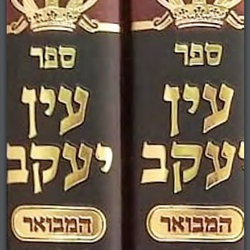About This Commentary
Language: Hebrew and Aramaic (עברית וארמית)
Style: Traditional Talmudic commentary
Focus: Aggadic sections of three sedarim
Coverage: Seder Nezikin, Seder Kodashim, Seder Toharot
Content: חידושים (original insights) on Ein Yaakov texts
This original Hebrew commentary provides חידושים on the aggadic sections of Seder Nezikin, Seder Kodashim, and Seder Toharot. Written in the traditional style of Talmudic commentaries, combining Hebrew and Aramaic, it is based on insights developed through hundreds of shiurim on Ein Yaakov.
Read Commentary
About Ein Yaakov
Ein Yaakov (עין יעקב) is a compilation of all the aggadic (non-legal) passages from the Babylonian and Jerusalem Talmuds, compiled by Rabbi Yaakov Ibn Habib (c. 1445-1516). This work made the rich aggadic literature of the Talmud accessible to a broader audience by organizing the narratives, parables, and ethical teachings into a coherent collection.
עין יעקב הוא קיבוץ כל האגדות שבתלמוד בבלי וירושלמי, שנערך על ידי רבי יעקב בן חביב. ספר זה הנגיש את עולם האגדה הקלאסי לקהל רחב יותר.
Commentary Approach
This commentary takes a traditional approach to understanding aggadic texts:
- Textual Analysis: Close reading of the aggadic passages
- Historical Context: Understanding the background of the teachings
- Moral Instruction: Extracting ethical lessons from the narratives
- Practical Application: Connecting ancient wisdom to contemporary life
Coverage by Seder
Seder Nezikin (סדר נזיקין)
Civil and Criminal Law
Commentary on aggadic sections dealing with justice, ethics, and interpersonal relationships.
Bava Kamma
Damages and compensation in Jewish law
Bava Metzia
Business ethics and found objects
Bava Batra
Property law and inheritance
Sanhedrin
Courts and capital punishment
Makkot
Lashes and cities of refuge
Eduyot
Testimonies and traditions
Avodah Zarah
Idolatry and interactions with non-Jews
Avot
Ethics of the Fathers
Horayot
Erroneous decisions by authorities
Seder Kodashim (סדר קדשים)
Temple Service and Sacrifices
Commentary on aggadic material related to Temple worship, holiness, and divine service.
Zevachim
Animal sacrifices
Chullin
Ritual slaughter and dietary laws
Bekhorot
Firstborn animals and redemption
Arakhin
Valuations and vows
Temurah
Substitution of sacrificial animals
Keritot
Excision penalties
Meilah
Misuse of sacred property
Tamid
Daily Temple service
Middot
Temple measurements
Seder Toharot (סדר טהרות)
Ritual Purity
Commentary on aggadic passages dealing with spiritual purity, cleanliness, and sanctity.
Kelim
Vessels and ritual impurity
Ohalot
Tent-like structures and impurity
Negaim
Leprosy-like afflictions
Parah
Red heifer purification
Toharot
General purity laws
Niddah
Laws of menstrual impurity
Makhshirin
Liquids that render food susceptible to impurity
Zavim
Male discharge impurity
Tevul Yom
One who immersed that day
Yadayim
Hand washing and impurity
Uktzin
Stems and shells of produce
Commentary Features
- Traditional Style: Written in the classical format of Talmudic commentaries
- Hebrew and Aramaic: Uses both languages appropriate to the original texts
- Source-Based: Built on extensive study of classical commentaries
- Practical Application: Connects ancient teachings to modern Jewish life
- Cross-References: Links related passages and concepts
Research Foundation
This commentary is based on:
- Hundreds of hours of Ein Yaakov shiurim
- Extensive study of classical commentaries
- Analysis of parallel passages in Talmudic literature
- Integration of medieval and modern interpretations
Target Audience
This commentary is designed for:
- Advanced Students: Those with background in Talmudic study
- Educators: Teachers of aggadic literature
- Scholars: Researchers in Talmudic studies
- Hebrew Readers: Those comfortable with classical Hebrew texts
Prerequisites
Recommended background includes:
- Familiarity with Talmudic Hebrew and Aramaic
- Understanding of aggadic interpretation methods
- Basic knowledge of Talmudic structure and terminology
- Appreciation for traditional Jewish textual analysis
Free Access and Study
In the tradition of הרבצת התורה, this commentary is freely available:
- Complete text accessible online without charge
- Downloadable for personal and educational use
- Shareable for Torah study purposes
- Encouraged distribution to promote Jewish learning
פירוש זה נכתב במטרה להעמיק את הלימוד באגדות חז״ל ולהפיץ את חכמת התורה. כל הזכויות נתונות לציבור למען הרבצת התורה.
